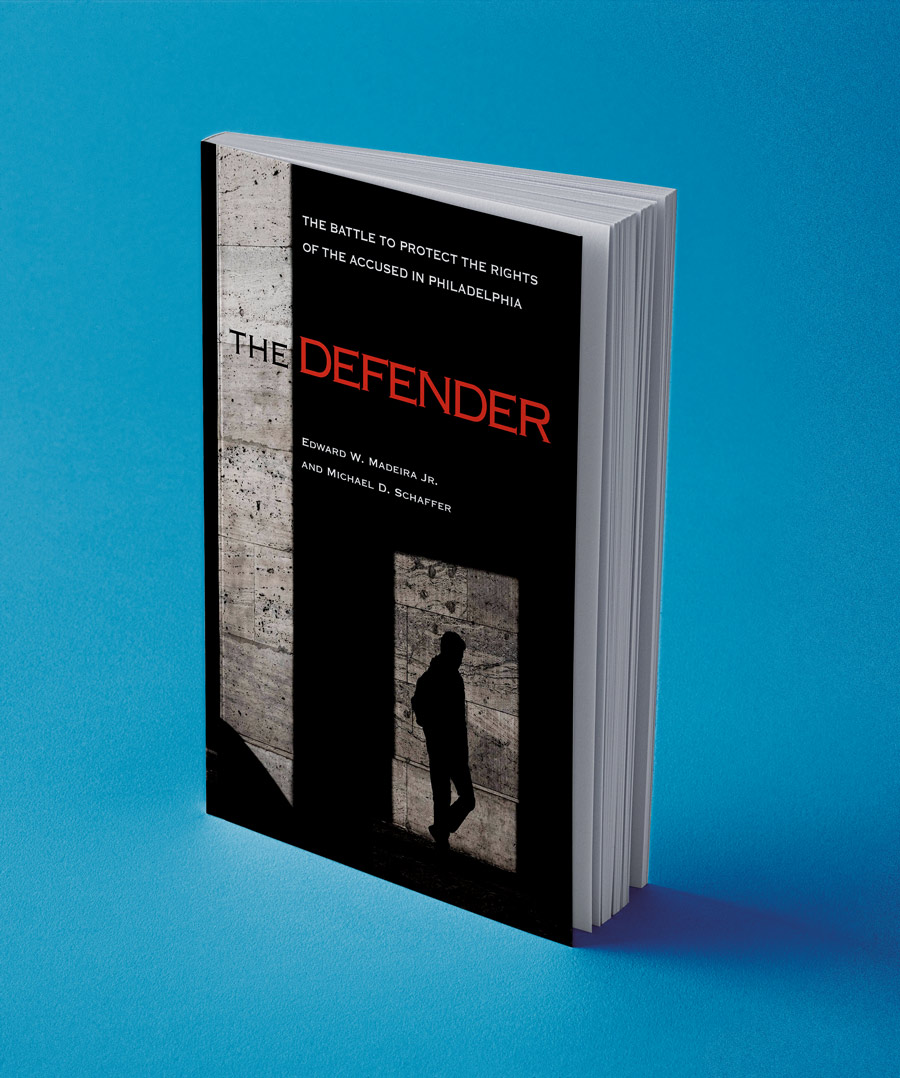The Story of the Trailblazing Defender Association of Philadelphia Runs Through Penn Law
The veteran Philadelphia Inquirer journalist, however, had limited knowledge of the city’s legal affairs. “When I was at the Inquirer, I did a lot of things, but never courts and never government,” Schaffer said.
That quickly changed as the two collaborated on The Defender: The Battle to Protect the Rights of the Accused in Philadelphia, recently published by Temple University Press. Although Madeira, longtime Chairman of the Association’s board died in May 2020 at the age of 92, he was pleased with the final manuscript of the book, Schaffer said.
Telling the Defender’s story, Schaffer discovered, not only put the spotlight on the organization that today operates as Philadelphia’s public defender office, but also on the Law School.
“One of the most fascinating things was that Penn Law School had a very important role,” he said. “In the early days in the ’60s, Penn Law School had a lot to do with the direction the Defender took.”


New book details the rich history of the Defender Association of Philadelphia and its enduring connection to the Law School.


New book details the rich history of the Defender Association of Philadelphia and its enduring connection to the Law School.
The Story of the Trailblazing Defender Association of Philadelphia Runs Through Penn Law
The veteran Philadelphia Inquirer journalist, however, had limited knowledge of the city’s legal affairs. “When I was at the Inquirer, I did a lot of things, but never courts and never government,” Schaffer said.
That quickly changed as the two collaborated on The Defender: The Battle to Protect the Rights of the Accused in Philadelphia, recently published by Temple University Press. Although Madeira, longtime Chairman of the Association’s board died in May 2020 at the age of 92, he was pleased with the final manuscript of the book, Schaffer said.
Telling the Defender’s story, Schaffer discovered, not only put the spotlight on the organization that today operates as Philadelphia’s public defender office, but also on the Law School.
“One of the most fascinating things was that Penn Law School had a very important role,” he said. “In the early days in the ’60s, Penn Law School had a lot to do with the direction the Defender took.”
“All of a sudden, wow, whoosh, everything mushrooms,” Schaffer said. “The Defender all of a sudden is finding itself doing mass defense.” That intensified in 1967 when the Supreme Court ruled to include defendants charged with misdemeanors.
Enter Penn Law Professor Tony Amsterdam L’60, PAR’92, who secured a sizeable Ford Foundation grant, said Professor David Rudovsky, who has been a Senior Fellow at Penn Law since 1988. The grant established a graduate program in criminal law and litigation in partnership with the Defender Association from 1966 to 1971. It funded four to five fellows per year chosen by Amsterdam for two-year fellowships at the Defender, along with about 50 supervised third-year students.
Amsterdam’s idea to funnel Penn Law fellows and students into the Defender was, at the time, revolutionary, said Rudovsky, who was one of the inaugural fellows. “When I went to law school in the ’60s, there were no clinical programs,” he said. “The program Amsterdam started was one of the first in the country.”
The Hon. Ben Lerner L’65, who was also one of Amsterdam’s fellows and eventually served as Chief of the Defender Association for 15 years, called the work done during the five-year grant transformative for the City.
“That work really changed the history of the Defender Association,” Judge Lerner said. “It changed the Defender Association from an organization that felt its only responsibility was to represent individual defendants in individual cases to an organization that could take the lead in criminal justice reform activities, both for reform litigation in the community and for constitutional alternative sentencing advocacy at a time when nobody had really heard of that.”
The Defender Association, as chronicled in the book, became a model organization as local governments across the country grappled with providing adequate counsel to indigent defendants. A defining factor, Rudovsky said, was its independence as a nonprofit. Such autonomy has allowed the Defender to tackle several law reform projects over the years, he said, particularly because of its amassed data on issues that affected a large number of clients, including bail reform and police misconduct in the form of improper search and seizure or interrogation of suspects. The “DNA revolution,” Rudovsky called it, exposed certain patterns and the fact that about 25 percent of rape and murder cases involved false convictions, which led to many exonerations.
Both Rudovsky and Judge Lerner noted that the majority of the people who got their feet wet as fellows eventually dedicated their careers to Philadelphia’s criminal justice system along with deep involvement in the Defender. Rudovsky, for instance, later served as First Assistant Defender and as President of the organization’s board of directors for many years.
“All of this happened because of the Penn connection,” Judge Lerner said.
After the Ford Foundation fellowship ended, Judge Lerner said he helped persuade the Law School to begin a Defender clinical program, which remains active. Rudovsky said dozens of Penn Law students participate in externships with the Defender every year and handle interviews, preliminary hearings and misdemeanor cases.
Schaffer, in becoming an authoritative voice on the Defender, sifted through countless records of Defender Association minutes and conducted numerous interviews with past and present litigators. “They’ve expanded over the years beyond simply being in the courtroom with clients,” he said, noting their involvement with alternative sentencing, as police watchdogs, and in cutting-edge juvenile justice.
Judge Lerner is enthusiastic that the account Schaffer penned — with Madeira’s guidance — will serve to inform how an iconic public defender’s office has impacted both Philadelphia and the nation at large.
“A lot of people,” he said, “don’t know how deeply its roots are sunk at 34th and Chestnut, and I think it’s a really interesting story.”